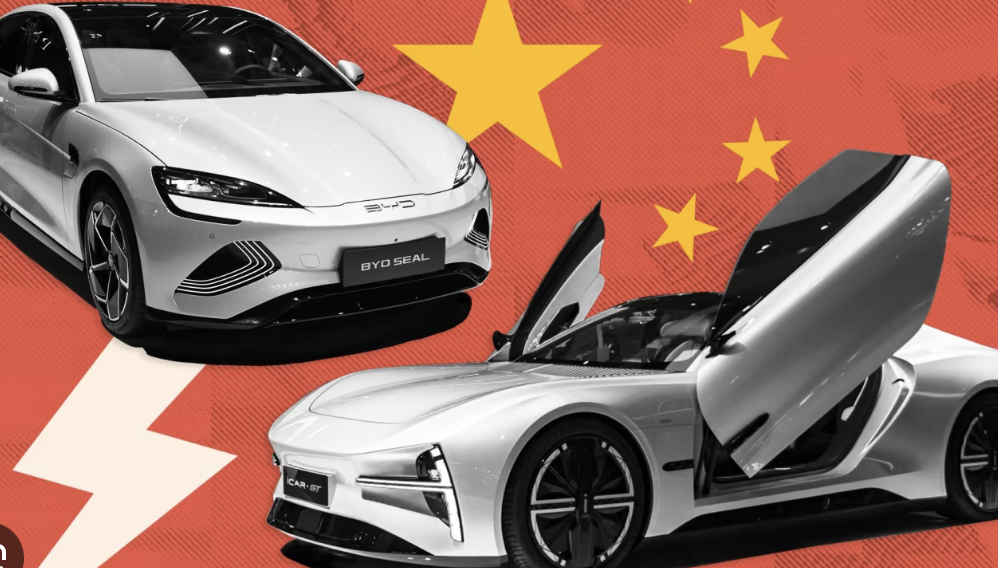Navigating The Complexities: Automakers Face Headwinds In The Chinese Market

Table of Contents
Intense Competition and Market Saturation
The Chinese auto market is fiercely competitive, a landscape shaped by the rise of domestic brands and the influx of new energy vehicle (NEV) startups. This intense competition and market saturation present significant hurdles for both established international players and newcomers alike.
Domestic Brands' Rise
Established domestic brands like Geely, BYD, and Great Wall Motors have significantly increased their market share, posing a formidable challenge to global automakers. The emergence of numerous ambitious NEV startups further intensifies the competition.
- Increased price wars: Domestic brands are aggressively competing on price, squeezing profit margins for international competitors.
- Focus on technological innovation: Domestic players are rapidly advancing in areas like battery technology, autonomous driving, and connected car features.
- Aggressive marketing strategies: Targeted marketing campaigns and strong brand building are key to the success of domestic brands.
The success of BYD, for example, demonstrates the power of a strong domestic brand leveraging technological innovation and aggressive marketing to capture significant market share. Their strong performance in the electric vehicle segment showcases the potential for domestic brands to dominate specific niches within the Chinese auto market.
Global Players' Struggle for Market Share
International automakers are facing increasing pressure to adapt their strategies to succeed in the Chinese auto market. The challenges are multifaceted, requiring significant investment and a deep understanding of the local market.
- Challenges in localization: Adapting products and marketing to the specific preferences of Chinese consumers is crucial but complex.
- Difficulties in adapting to consumer preferences: Understanding the nuances of Chinese consumer preferences regarding design, features, and branding is critical.
- Need for significant investment in R&D: To compete with domestic rivals, international automakers need to invest heavily in research and development of advanced technologies.
Many international brands have struggled to gain significant market share, highlighting the need for a localized approach that goes beyond simple product adaptation. Companies that have successfully navigated this landscape have done so by prioritizing localization efforts and establishing strong partnerships within the Chinese market.
Shifting Consumer Preferences and Demands
The preferences of Chinese consumers are rapidly evolving, driven by technological advancements and government policies. Understanding and adapting to these shifting demands is crucial for success in the Chinese auto market.
Growing Demand for Electric Vehicles (EVs)
The Chinese government's strong push for electric vehicles (EVs) through substantial subsidies and the development of charging infrastructure has fueled immense consumer interest. This rapidly expanding segment presents both opportunities and challenges.
- Government subsidies: Significant financial incentives encourage consumers to purchase EVs.
- Charging infrastructure development: A growing network of charging stations is addressing range anxiety concerns.
- Consumer preference for EVs: Chinese consumers are increasingly embracing EVs due to environmental concerns and technological appeal.
The growth of the EV market in China is staggering, with domestic brands like BYD leading the charge. International automakers must significantly increase their investment in EV technology and production to compete effectively in this crucial segment.
Focus on Technology and Connectivity
Chinese consumers increasingly value advanced technology and connected car features. This focus on technological innovation and connectivity is reshaping the automotive landscape.
- Autonomous driving features: Self-driving capabilities and advanced driver-assistance systems are highly sought after.
- Internet connectivity: Seamless integration with mobile devices and online services is essential.
- Infotainment systems: Sophisticated infotainment systems with intuitive interfaces are a key selling point.
Automakers need to integrate the latest technologies into their vehicles to meet the expectations of tech-savvy Chinese consumers. Failing to provide advanced technological features can result in a significant loss of market share.
Regulatory Hurdles and Government Policies
The Chinese automotive market is subject to stringent regulations and complex bureaucratic processes. Navigating these regulatory hurdles is a significant challenge for automakers.
Stringent Emission Standards and Regulations
China's commitment to reducing emissions has resulted in the implementation of increasingly stringent environmental regulations. This necessitates significant investments in cleaner technologies.
- Compliance costs: Meeting emission standards can be expensive, impacting profitability.
- Technology adaptation challenges: Adopting new technologies to meet these standards requires significant R&D investment.
- Impact on profitability: The cost of compliance can significantly affect the overall profitability of automotive businesses.
The stringent emission regulations are pushing automakers to accelerate the development and adoption of cleaner technologies, such as EVs and hybrid vehicles.
Navigating Bureaucracy and Local Regulations
Operating in the vast and diverse Chinese market involves navigating a complex web of bureaucratic processes and varying local regulations.
- Licensing: Obtaining necessary licenses and permits can be a time-consuming process.
- Import/export procedures: Complex import and export regulations can add to operational costs.
- Local content requirements: Regulations often mandate a certain percentage of locally sourced components.
Understanding and managing these complexities is essential for foreign automakers looking to establish a successful presence in the Chinese market. Strong partnerships with local companies and expert legal advice are vital to successfully navigating these hurdles.
Conclusion
The Chinese auto market presents a complex and dynamic landscape for both domestic and international players. Navigating the intense competition, evolving consumer preferences, and stringent regulations requires a strategic approach that incorporates localization, technological innovation, and a deep understanding of the local market. While challenges are substantial, the sheer size and growth potential of the Chinese auto market continue to attract significant investment and remain a crucial market for global automakers. Successfully navigating this complex environment requires a long-term commitment to understanding and adapting to the unique demands of the Chinese auto market. Are you prepared to meet the challenge and succeed in this crucial market?

Featured Posts
-
 Teslas Q1 Financial Results The Musk Effect And Market Reaction
Apr 24, 2025
Teslas Q1 Financial Results The Musk Effect And Market Reaction
Apr 24, 2025 -
 Uil State Bound Hisd Mariachis Viral Whataburger Moment
Apr 24, 2025
Uil State Bound Hisd Mariachis Viral Whataburger Moment
Apr 24, 2025 -
 Positive Market Sentiment Fueling The Niftys Bullish Charge In India
Apr 24, 2025
Positive Market Sentiment Fueling The Niftys Bullish Charge In India
Apr 24, 2025 -
 Deportation Flights A New Revenue Stream For A Budget Airline
Apr 24, 2025
Deportation Flights A New Revenue Stream For A Budget Airline
Apr 24, 2025 -
 The Trump Administrations Immigration Crackdown A Legal Analysis
Apr 24, 2025
The Trump Administrations Immigration Crackdown A Legal Analysis
Apr 24, 2025
